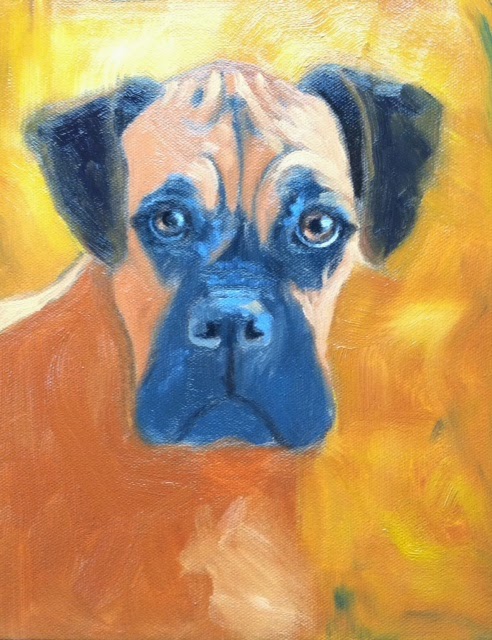After studying the regal look and features of this beautiful
German Shorthaired Pointer, I told my client I was going to give him the title of "Sir" Stubby. He has such a strong, confident look about him. (He was named Stubby because of the shape of his tail.)
.JPG) |
"Sir" Stubby
8 x 10", Oil on canvas
Rita Salazar Dickerson |
.JPG) |
| Stage 1: Drawing and blocking in (painting the first layer of shapes and values) the subject. With a thin wash of burnt umber paint and mineral spirits, I loosely drew in the shapes and features, using a soft cloth to erase and make adjustments. |
.JPG) |
| Stage 2: Completing the portrait. For the second layer, I like to start with the eyes and then build the painting from there. The eyes become the focal point and well as my point of reference for the rest of Stubby's features. |
.JPG) |
Stubby has rich features, contrasts and color. I enjoyed painting his spots, keeping them clear but with soft edges. His sun bleached coat added reds and lighter browns to his coloring. Once I felt like Stubby was close to completion I painted in the background of blues and browns to visually give the painting a sense of cohesiveness.
"Sir" Stubby II
I was fortunate to receive two portrait commissions of Stubby. This second portrait features him in an outdoor setting with the lighting enhancing Stubby's darker coat. (The reference photo I used was taken at a different time period from his first portrait). Stubby looks free and full of energy, as though he stopped running in the fields just long enough to have his photo taken.
|
 |
| Stage 1: Drawing and blocking in the subject and creating the composition. Working a landscape into the composition made this an interesting challenge. I didn't want the background to over power the dog. I intentionally kept the edges soft. |
 |
"Sir" Stubby II
8 x 10", Oil on canvas
Rita Salazar Dickerson
Stage 2: Completing the portrait. Putting Stubby in the great outdoors makes this portrait unique from the first one. Having his mouth open also sets this one apart. I enjoyed painting in the fall colors and hints of water from a creek. The gold flecks in his eyes reflects the color around him. The browns and golds throughout the painting tied the colors in to each other.
As usual, I am always pleased when I have completed a commission(s) but just a little bit sad too. |
.JPG)

.JPG)
.JPG)







.JPG)
.JPG)
.JPG)
.JPG)
.JPG)
.JPG)
.JPG)

.JPG)